
PC1
⁄
3, PC2 and PC5
⁄
6A are targeted to dense core
secretory granules by a common mechanism
Jimmy D. Dikeakos
1
, Chantal Mercure
1
, Marie-Jose
´e Lacombe
1
, Nabil G. Seidah
2
and
Timothy L. Reudelhuber
1
1 Laboratory of Molecular Biochemistry of Hypertension, Institut de Recherches Cliniques de Montre
´al (IRCM), QC, Canada
2 Laboratory of Biochemical Neuroendocrinology, Institut de Recherches Cliniques de Montre
´al (IRCM), QC, Canada
The proprotein convertases (PCs) constitute a distinct
family of serine proteases related to bacterial subtilisin
and the yeast kexin proteases. The PC enzymes cleave
their substrates after paired basic amino acids, and they
are known to participate in the proteolytic activation of
a variety of hormones, growth factors, enzymes, recep-
tors and viruses, either in the secretory pathway or after
secretion from the cell [1]. Upon entry into the trans-
Golgi network (TGN), the majority of the PC enzymes,
including furin, PC4, PACE4 and PC7, enter low-den-
sity secretory vesicles and are secreted from cells in a
constitutive manner. Only three of the seven known
basic amino acid-specific PC enzymes, PC1 ⁄3, PC2 and
PC5 ⁄6A, are selectively targeted to dense core secretory
granules of endocrine and neuroendocrine cells, where
they activate their substrates. Targeting of proteins to
dense core secretory granules requires the recognition of
one or more sorting signals in the TGN, and granule-
resident proteins are either selectively included or
retained in nascent secretory granules [2]. The resulting
secretory granules subsequently undergo a series of
maturation steps that include processing of hormone
precursors, condensation to form a dense core, and
docking at the plasma membrane. Because dense core
secretory granules are released from the cell in response
to a physiologic stimulus, this mechanism of secretion is
referred to as the regulated secretory pathway. Whereas
the transit time through the regulated secretory pathway
is in the order of hours, transit through the constitutive
secretory pathway can be completed within minutes.
The various PC enzymes share a common general
structure that includes an N-terminal prosegment which
Keywords
alpha helix; PC5/6; proprotein convertases;
regulated secretion; secretory granules
Correspondence
T. L. Reudelhuber, IRCM, 110, avenue
des Pins Ouest, Montreal (QC),
Canada H2W 1R7
Fax: +1 514 987 5717
Tel: +1 514 987 5716
E-mail: reudelt@ircm.qc.ca
(Received 4 May 2007, revised 7 June
2007, accepted 13 June 2007)
doi:10.1111/j.1742-4658.2007.05937.x
There are seven members of the proprotein convertase (PC) family of secre-
ted serine proteases that cleave their substrates at basic amino acids,
thereby activating a variety of hormones, growth factors, and viruses.
PC1 ⁄3, PC2 and PC5 ⁄6A are the only members of the PC family that are
targeted to dense core secretory granules, where they carry out the process-
ing of proteins that are secreted from the cell in a regulated manner. Previ-
ous studies have identified a-helices in the C-termini of the PC1 ⁄3 and PC2
proteases that are required for this subcellular targeting. In the current
study, we demonstrate that a predicted a-helix in the C-terminus of
PC5 ⁄6A is also critical for the ability of this domain to target a hetero-
logous protein to the regulated secretory pathway of mouse endocrine
AtT-20 cells. Analysis of the subcellular distribution of fusion proteins con-
taining the C-terminal domains of PC1 ⁄3, PC2 and PC5 ⁄6A confirmed that
all three domains have the capacity to redirect a constitutively secreted pro-
tein to the granule-containing cytoplasmic extensions. Analysis of the pre-
dicted structures formed by these three granule-sorting helices shows a
correlation between their granule-sorting efficiency and the clustering of
hydrophobic amino acids in their granule-targeting helices.
Abbreviations
ACTH, adrenocorticotropic hormone; PC, proprotein convertase; POMC, proopiomelanocortin; TGN, trans-Golgi network.
4094 FEBS Journal 274 (2007) 4094–4102 ª2007 The Authors Journal compilation ª2007 FEBS

is autocatalytically cleaved, a central catalytic domain
comprising the catalytic triad of amino acids aspartic
acid, histidine and serine, and a stabilizing P-domain
involved in the binding of Ca
2+
[1]. The C-terminal
domains of the PC enzymes exhibit the least amount of
homology between the family members. Several lines
of evidence suggest that the granule-sorting signals for
PC1 ⁄3, PC2 and PC5 ⁄6A reside in the C-terminal
domain of these enzymes. PC1 ⁄3 devoid of its C-ter-
minal domain is efficiently expressed and enzymatically
active, but no longer enters the regulated secretory path-
way [3,4]. A predicted amphipathic a-helix in the last 43
amino acids at the C-terminus of PC1 ⁄3 is necessary for
this domain to target a heterologous fusion protein to
secretory granules, and mediates the interaction of this
domain with the membrane fraction of expressing cells
[3]. Likewise, a protein domain in the C-terminal tail of
PC2 is capable of redirecting heterologous proteins to
secretory granules [5,6]. This sorting activity is con-
tained in the last 25 amino acids of PC2, which have
been reported to form an amphipathic a-helix capable
of interacting with raft resident lipids [6].
The granule-targeting domain of the PC5 ⁄6A pro-
tease has been less well defined. Alternative splicing
produces two forms of PC5 ⁄6A that differ in their
C-termini [1]: The longer form (PC5B) contains a
C-terminal transmembrane domain that retains the
enzyme in the Golgi apparatus. The shorter form,
PC5 ⁄6A, is secreted by both the constitutive and regu-
lated secretory pathways. As in PC1 ⁄3, the C-terminal
tail of PC5 ⁄6A is removed by a proteolytic cleavage
once it enters secretory granules [7]. Engineered dele-
tion of the last 38 residues within this C-terminal tail
of PC5 ⁄6A leads to its exclusive secretion from the
constitutive secretory pathway [8], consistent with the
existence of a secretory granule-sorting signal in this
domain. In the current study, we sought to define the
secretory sorting signals in the PC5 ⁄6A C-terminus
and to compare these to the granule-sorting domains
in the other granule-targeted PC family enzymes. Our
results suggest that PC1 ⁄3, PC2 and PC5 ⁄6A share a
common sorting mechanism defined by an a-helix
whose efficiency correlates with the clustering of
hydrophobic residues on a face of the helix.
Results
The secretory granule-sorting domain of PC5
⁄
6A
is contained in the last 38 amino acids of the
C-terminus
Previous results had shown that PC5 ⁄6A in which the
C-terminal 38 amino acids were deleted failed to enter
secretory granules [8]. In order to further define the
PC5 ⁄6A secretory granule-sorting signal, both the
entire PC5 ⁄6A C-terminal tail (688–915) and the last
38 amino acids were tested for their ability to redirect
a constitutively secreted protein into the secretory
granules of mouse corticotropic AtT-20 cells (Fig. 1)
either in the absence or in the presence of forskolin, a
secretagogue that increases intracellular cAMP levels,
resulting in the release of secretory granules [9].
AtT-20 cells contain dense core secretory granules in
which endogenous proopiomelanocortin (POMC) is
processed into adrenocorticotropic hormone (ACTH)
by a series of proteolytic cleavages involving PC1 ⁄3
[1]. As we have previously shown [3], a recombinant
protein containing a single-chain fragment of the
mouse IgG heavy chain constant region is secreted
constitutively (i.e. not retained in granules) when
expressed in these cells, as evidenced by its continued
secretion into the supernatant after a 16 h chase period
(Fig. 1B, Fc). After the chase period, there is a roughly
1.5-fold stimulation of secretion of the small amount
of Fc protein remaining in the cells as determined by
comparing levels secreted in the absence (– F; constitu-
tive secretion) and presence (+ F; regulated secretion)
of forskolin (Fig. 1C, Fc). By comparison, the secre-
tion of endogenous granule-resident b-endorphin is
stimulated roughly 2.1-fold by the same treatment
[2.1-fold ± 0.12 (SEM), n¼15]. The low extent of
intracellular protein retention and forskolin-stimulated
secretion of the Fc protein thereby constitute the base-
line for analyzing potential granule-sorting domains.
Attachment of the entire 228 amino acid C-terminal
tail of PC5 ⁄6A to the Fc fusion protein causes a signi-
ficant increase in its retention in the cell and its regula-
ted secretion (Fig. 1B,C, 688–915), confirming that this
region of the protein contains a granule-sorting signal.
Notably, attachment of the last 38 amino acids of the
C-terminus to the fusion protein results in an equival-
ent redirection of the fusion protein to the regulated
secretory pathway (Fig. 1B,C, 878–915) suggesting that
the PC5 ⁄6A secretory granule-sorting signal is entirely
contained within the C-terminal 38 amino acids of
PC5 ⁄6A.
The PC5
⁄
6A secretory granule-sorting domain is
predicted to form an a-helix
The secretory granule-sorting domains of PC1 ⁄3 and
PC2 correspond to regions predicted to form a-helices
[3,6]. In order to determine whether the same is true
for the granule-sorting domain of PC5 ⁄6A, we ana-
lyzed this domain using two different protein structure
prediction algorithms. Both jnet [10] and prof [11]
J. D. Dikeakos et al.Granule targeting of PC family enzymes
FEBS Journal 274 (2007) 4094–4102 ª2007 The Authors Journal compilation ª2007 FEBS 4095

predict the formation of a helix in the C-terminal half
of this domain, roughly centered over residues 897–
910, as well as a short region in the N-terminal portion
of the fragment (Fig. 2, 880–884, overlines). To test
whether the C-terminal helix corresponds to the secre-
tory granule-sorting activity, serial deletions that
remove either part or all of the predicted helix were
made. Secretion analysis demonstrated that both of
the fusion proteins containing C-terminal deletions
show reduced sorting efficiency as compared to protein
containing the intact 38 amino acid domain
(Fig. 2B,C, compare 878–906 and 878–891 with 878–
915). Moreover, this reduction in sorting efficiency cor-
relates with disruption of the predicted a-helix in this
region (see overlines on Fig. 2A, 878–906 and 878–
891). To further confirm that the observed effects were
due to deletion of functional sorting elements, a five
amino acid deletion was made in the N-terminal end
of the PC5 ⁄6A peptide, resulting in a disruption of the
short helix predicted in that portion of the molecule
(Fig. 2A, 883–915, missing overlines). Secretion analy-
sis in transfected AtT-20 cells revealed that this fusion
protein sorts to secretory granules with the same effi-
ciency as the fusion protein containing the entire 38
amino acid sorting domain (Fig. 2B,C, compare 878–
915 with 883–915). In conclusion, the PC5 ⁄6A C-ter-
minal tail contains a secretory granule-sorting signal
whose function, like those of PC1 ⁄3 and PC2, corre-
lates with the predicted formation of an a-helix.
The minimal granule-sorting domains of PC1
⁄
3,
PC2 and PC5
⁄
6A selectively redirect a constitutive
protein to granules
To compare the sorting properties of the PC5 ⁄6A
C-terminal tail with those previously identified in
Fc
sp Fc
FcPC5/6A
C-term
sp pro catalytic P
687 915
Fc
688-915
878-915
0
1
2
3
4
*
*** n.s.
Fold stimulation
(+F/-F)
688-915
878-915
PC5/6A 878
Fc
-F +F-F
CC
A
BC
FcPC5/6A
688-915
878-915
Fig. 1. The PC5 ⁄6A granule-sorting domain is contained in the last 38 amino acids of its C-terminus. (A) Upper: Schematic representation of
PC5 ⁄6A showing the signal peptide (sp.) prosegment (pro), catalytic domain, P domain (P) and autocatalytically cleaved C-terminal domain
(C-term). The speckled area represents the region deleted by de Bie et al. [8], resulting in loss of secretory granule sorting. Lower: Sche-
matic representation of the fusion proteins used to test for secretory granule targeting. sp., signal peptide; Fc, portion of the mouse IgG
2b
;
PC5 ⁄6A, various portions of the PC5 ⁄6A C-terminus as indicated (numbering is relative to the initiator methionine). (B) Representative pulse-
chase assay for regulated secretion of the fusion proteins in AtT-20 cells. Parallel wells of stably transfected AtT-20 cell pools expressing
the various fusion proteins were pulse-labeled for 2 h and chased with unlabeled medium for an additional 16 h. After the chase period, the
supernatants were collected from the parallel wells (two lanes labeled C), and the cells were subsequently incubated for an additional 3 h
either in the absence (– F) or in the presence (+ F) of the secretagogue forskolin. Fc-containing proteins in the culture supernatants were
immunoprecipitated with protein A sepharose, separated by SDS ⁄PAGE, and detected by fluorography. (C) Autoradiograms similar to those
shown in (B) were exposed to storage phosphor screen and quantified. The ratios (mean ± SEM) of fusion protein content in the regulated
(+ F) versus constitutive (– F) secretion incubations are shown. n¼4–12 independent transfections. ***P<0.001, *P<0.05, versus Fc by
one-way ANOVA with Dunnet’s post test. n.s., not significant.
Granule targeting of PC family enzymes J. D. Dikeakos et al.
4096 FEBS Journal 274 (2007) 4094–4102 ª2007 The Authors Journal compilation ª2007 FEBS

PC1 ⁄3 and PC2, we tested their ability to redirect the
Fc protein to the granule-containing regions in AtT-20
cells. In order to reduce experimental artefact that
might result from varying levels of fusion protein
expression, we isolated clonal lines of stably transfect-
ed AtT-20 cells that were selected for comparable
levels of expression of the various fusion proteins
(Fig. 3B). In addition, to ensure that the levels of
expression of the fusion proteins did not saturate the
endogenous sorting machinery, we verified that endog-
enous PC1 ⁄3 secretion and the conversion of PC1 ⁄3
from the 87 kDa form to the 66 kDa C-terminal-trun-
cated form (a secretory granule phenomenon) were not
affected (Fig. 3B, endogenous PC1 ⁄3). In agreement
with our previous results [3], staining of transfected
cells with an antibody to the mouse immunoglobulin
(Fc) domain of the fusion protein revealed its presence
predominantly in the TGN (Fig. 3C, open arrows) and
in a diffuse pattern throughout the cytoplasm of
expressing cells. This is the pattern expected for a con-
stitutively secreted protein that transits from the TGN
to low-density secretory vesicles. In contrast, inclusion
of the C-terminal domain of either FcPC1 ⁄3, PC2 or
PC5 ⁄6A results in detection of the fusion protein not
only in the TGN (open arrows) but also in cytoplasmic
extensions (closed arrow), with the most intense stain-
ing being in the extensions. Concomitant staining with
an antibody that detects both POMC and ACTH
shows an identical spatial distribution of staining, with
roughly equivalent localization in the TGN (POMC)
and granule-containing cytoplasmic extensions (ACTH).
Thus, the C-terminal domains of PC1 ⁄3, PC2 and
PC5 ⁄6A are all equally capable of redirecting a consti-
tutively secreted protein to granule-containing cyto-
plasmic extensions in AtT-20 cells.
Structural correlates of sorting efficiency
In an effort to better understand the granule-sorting
properties of the C-terminal a-helices in PC1 ⁄3, PC2
and PC5 ⁄6A, we compared their predicted biophysical
characteristics. The efficiency of sorting of the predic-
ted helices did not correlate with their length; whereas
the sorting helices of PC1 ⁄3 and PC5 ⁄6A are predicted
to cover 14 amino acids, the PC2 helix extends over 28
amino acids (Fig. 3A, overlines). In addition, the sort-
ing efficiency did not correlate with predicted isoelec-
tric points, as the PC1 ⁄3 and PC2 helices are predicted
to be acidic, whereas the PC5 sorting helix is very
basic (Fig. 4, pI). Helical wheel projections revealed
that whereas both the PC1 ⁄3 and PC2 helices were
amphipathic (i.e. had a segregation of hydrophobic
and polar faces on the helix), the PC5 ⁄6A helix had a
relatively uniform distribution of hydrophobic residues
(boxed) around the helix (Fig. 4, left). Interestingly,
helical net projections, which represent a side view of
the helix as if it had been sliced open and flattened,
reveals that the more hydrophobic residues (L, I and
V) are present in clusters on the surface of all three
helices, but in the PC1 ⁄3 helix these residues are more
PC5/6A
…ATEESWAEGGFCMLVKKNNLCQRKVLQQLCCKTCTFQG
Fc
FcPC5/6A
878-915
…ATEESWAEGGFCMLVKKNNLCQRKVLQQL
878-906
…ATEESWAEGGFCMLVKKNNL
878-891
878-915
878-906
878-891
883-915
0
1
2
3
*
***
Fold stimulation
(+F/-F)
…WAEGGFCMLVKKNNLCQRKVLQQLCCKTCTFQG
883-915
-F +FCC-F
A
BC
878-915
883-915
878-906
878-891
FcPC5/6A
Fig. 2. The PC5 ⁄6A C-terminus contains a
granule-sorting domain predicted to form an
a-helix. (A) Schematic representation of the
PC5 ⁄6A C-terminal domains tested for regu-
lated secretion. Overlined regions were pre-
dicted to form a-helices by either the JPRED
(solid line) or PROF (hatched ⁄dotted line)
algorithms. (B) Representative fluorogram of
supernatants from transfected AtT-20 cells.
(C) Quantitative analysis of fusion protein
sorting to the regulated secretory pathway.
n¼4–12 independent transfections.
***P<0.001, *P<0.05, versus Fc PC5 ⁄6A
878–915. See Fig. 1 legend for additional
details.
J. D. Dikeakos et al.Granule targeting of PC family enzymes
FEBS Journal 274 (2007) 4094–4102 ª2007 The Authors Journal compilation ª2007 FEBS 4097

abundant and are predicted to be more tightly clus-
tered on the helix surface (Fig. 4, right).
Discussion
Many peptide hormones (such as insulin, ACTH and
others) are only bioactive after selective cleavage of
their precursor proteins in secretory granules by PC
enzymes such as PC1 ⁄3, PC2 or PC5 ⁄6A. Understand-
ing how these enzymes and their substrates are tar-
geted to secretory granules is thus critical in
understanding this key cellular process in endocrinol-
ogy. The current results suggest that the secretory
granule-targeting domain of PC5 ⁄6A is composed of a
C-terminal region predicted to form an a-helix, as had
been previously reported for PC1 ⁄3 and PC2, and
suggests that the three members of the PC family that
are targeted to dense core secretory granules share a
common sorting mechanism. Although these studies
were carried out using engineered fusion proteins, sev-
eral studies have now shown that removal of the C-ter-
minal tails in the otherwise intact PC1 ⁄3, PC2 and
PC5 ⁄6A enzymes prevents their sorting to dense core
secretory granules [3–6,8], confirming the importance
of these domains in the context of the native proteins.
a-Helical sequences involved in sorting proteins to
secretory granules have also been observed in other
proteins: prosomatostatin contains an a-helix in its
N-terminal region that is sufficient for targeting to
secretory granules [12]. Carboxypeptidase E also con-
tains an a-helix in its C-terminus that is critical for
sorting the protein to secretory granules and that has
AC
B
Fig. 3. Comparison of the sorting capacity of fusion proteins containing various PC family C-termini. (A) Schematic representation of the
C-terminal domains tested for regulated secretion. Overlined regions were predicted to form a-helices by either the JPRED (solid line) or PROF
(hatched ⁄dotted line) algorithms. (B) Clonal cell lines were selected from AtT-20 cell pools, labeled with [
35
S]methionine for 1 h, and chased
for 2 h in complete medium. The chase supernatant was simultaneously immunoprecipitated for the fusion protein and endogenous PC1 ⁄3,
and the precipitated proteins were subjected to SDS ⁄PAGE and fluorography. Note that the level of secretion of each of the various fusion
proteins was comparable between the different cell lines. In addition, expression of the fusion proteins did not interfere with secretion of
the endogenous PC1 ⁄3 (87 kDa and 66 kDa forms). (C) Subcellular distribution of fusion proteins in transfected AtT-20 cells immunolabeled
with antibody to the various fusion proteins (Fc; left panel) or endogenous POMC ⁄ACTH (middle panel). The red staining (middle panels)
shows the distribution of endogenous ACTH (present primarily in dense core secretory granules) and its precursor POMC (primarily present
in the endoplasmic reticulum and Golgi apparatus). Note the relative staining distribution of the fusion proteins between the TGN (open
arrows), the cytoplasmic region, and the granule-containing cytoplasmic extensions (closed arrows). The micrographs shown are typical of
the staining pattern seen in > 50 cells examined in four independent experiments.
Granule targeting of PC family enzymes J. D. Dikeakos et al.
4098 FEBS Journal 274 (2007) 4094–4102 ª2007 The Authors Journal compilation ª2007 FEBS



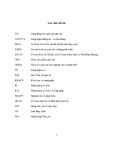

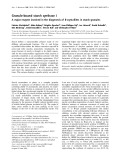
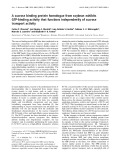
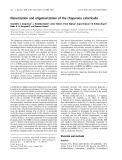
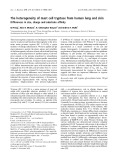
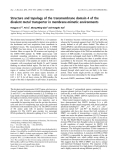
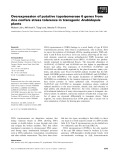





![Báo cáo seminar chuyên ngành Công nghệ hóa học và thực phẩm [Mới nhất]](https://cdn.tailieu.vn/images/document/thumbnail/2025/20250711/hienkelvinzoi@gmail.com/135x160/47051752458701.jpg)









